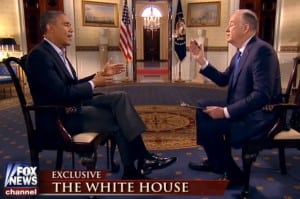During President Obama’s interview on Super Bowl Sunday with Fox News Channel’s Bill O’Reilly, the president and O’Reilly sparred about last year’s attack on the American consulate in Benghazi, Libya. When trying to get his message across the president could barely get a word in edgewise, with O’Reilly interrupting him at every turn. But what’s good for the goose is good for the gander. Obama “overlapped,” or spoke over O’Reilly’s questions, nearly two dozen times during the 10-minute conversation, according to Carin Warner, president of PR agency Warner Communications.
“That’s a no-no,” she said. “When coaching clients the number one thing I advise businesspeople is to let the reporter finish the question. It speaks to the overall tone of the interview. She added: “It doesn’t make a C-level executive look like an authentic person unless the person is really listening and answering all the reporter’s questions…Today’s audiences are more sophisticated than ever. They want the answers to the questions.”
Kabuki theater aside, the exchange between President Obama and Bill O’Reilly underscores the very nature of the testy media interview.
Of course, PR pros take pains to plan for interviews that are sure to include some hardball and/or uncomfortable questions.
However, it’s one thing for a top executive to be camera-ready for a media interview and know his talking points cold. It’s another when the reporter has a bone to pick with the executive, has a habit of interrupting the responses and can barely contain his or her hostility toward the brand or organization.
When faced with such a situation, C-level executives may opt to control the conversation, in which case they’ll probably come off as peevish and undisciplined. Another option is to play nice and answer nettlesome questions as generically as possible, for fear that getting stuck in the weeds might alienate customers and/or prospects. But that can backfire as well.
“You can’t please everybody,” Warner said. “If you’re looking to placate all audiences you end up looking weak.”

ADVANCE PLANNING
Warner said that when planning for the unpredictable interview, advance work is crucial. “You have to consider whether the C-level executive is cut out for that kind of interview,” she said. If not—and you don’t want to jeopardize the opportunity—the onus is on the PR executive to say that a different senior-level executive perhaps would be more effective at handling that particular interview. “We have to be as tough with our clients to help them as we expect the media to be with the executive. We owe them our opinion,” she said.
Jerry Doyle, principal at CommCore Consulting, recalls recently preparing a client in the pharmaceutical industry for a press conference following a regulatory verdict that was generally favorable to drug companies. He could not name the company represented.
Yet the reporters covering the story had preconceived notions about the wisdom of the new regulation, Doyle said. “The strategy was to validate dissension but, at the same time, weigh the data supporting the regulation,” he said. “There’s safety in facts, but we weren’t dismissive of any questions.”
EMBRACE DISSENSION
Doyle said the client was pleased with the results of the press conference. “The goal was not to debate and change the mind of the interviewer,” he said. “The goal was to make sure the interview didn’t devolve into pure animus, so the resulting articles had [the client’s] message in those articles.”
Doyle provided three recommendations on how to prepare C-level execs (or yourself, for that matter) for the unpredictable interview.
1. Awareness. Separate the questioner from his or her audience. Don’t play into the negative queries, but think about who the “end user” is and the message you ultimately want to send via the interview.
2. It’s not a debate. Stand your ground when asked a loaded question. You may disagree, respectfully, but you do your brand no favors by having a disagreement turn into a less-than-edifying debate.
3. Exorcise any condescension. Viewers can smell a condescending tone a mile away, so keep that tendency at bay.
Despite your best efforts, if an interview with a C-level executive takes an ugly turn, the PR person needs to interject himself and remind the reporter the reason for the interview in the first place, said Bob Christie, managing director at Burson-Marsteller.
But the overall goal is not to allow that to happen. “Our responsibility as communicators is to make sure you have proactively vetted the opportunity,” Christie said, “and understand the position you’re putting the client in.” PRN
CONTACT:
Bob Christie, [email protected]; Jerry Doyle, [email protected]; Carin Warner, [email protected].
Tips for Mastering Media Curveballs
 We’ve all been there, whether with a client or as the interviewee. You do your research, confirm topics and general questions to be prepared for and—boom—the reporter changes direction mid-interview. So what do you do?
We’ve all been there, whether with a client or as the interviewee. You do your research, confirm topics and general questions to be prepared for and—boom—the reporter changes direction mid-interview. So what do you do?
1. Expect the unexpected. Know your reporter. What’s their general interview style? Do they typically throw curveballs? If so, work with a colleague or your communications team to brainstorm any and all scenarios. Also, be sure to brush up on industry news and general current events prior; you never know what might come up.
2. Own it. Be proactive with your messages, don’t just answer questions. Start every interview with a game plan and ideal outcome in mind. If the reporter doesn’t bring up a topic you want to cover, you should. On the flip side, if you get blindsided practice the art of transition: Deflect tough questions, keep the interviewer and yourself on track and, most important, don’t repeat the negative.
3. Don’t let ’em see you sweat. Often, reporters ask off-topic questions to get you to reveal something they want to know but know you don’t want to talk about. No matter what you are asked, maintain your poker face and answer the question. Yes, you need to acknowledge it was asked, provide an answer and then move on. How? See number 2.
This sidebar was written by Melissa Vigue, director at Peppercomm. She can be reached at [email protected].
The story originally ran in the Feb. 10, 2014 issue of PR News.
Read more subscriber-only content by becoming a PR News subscriber today.
